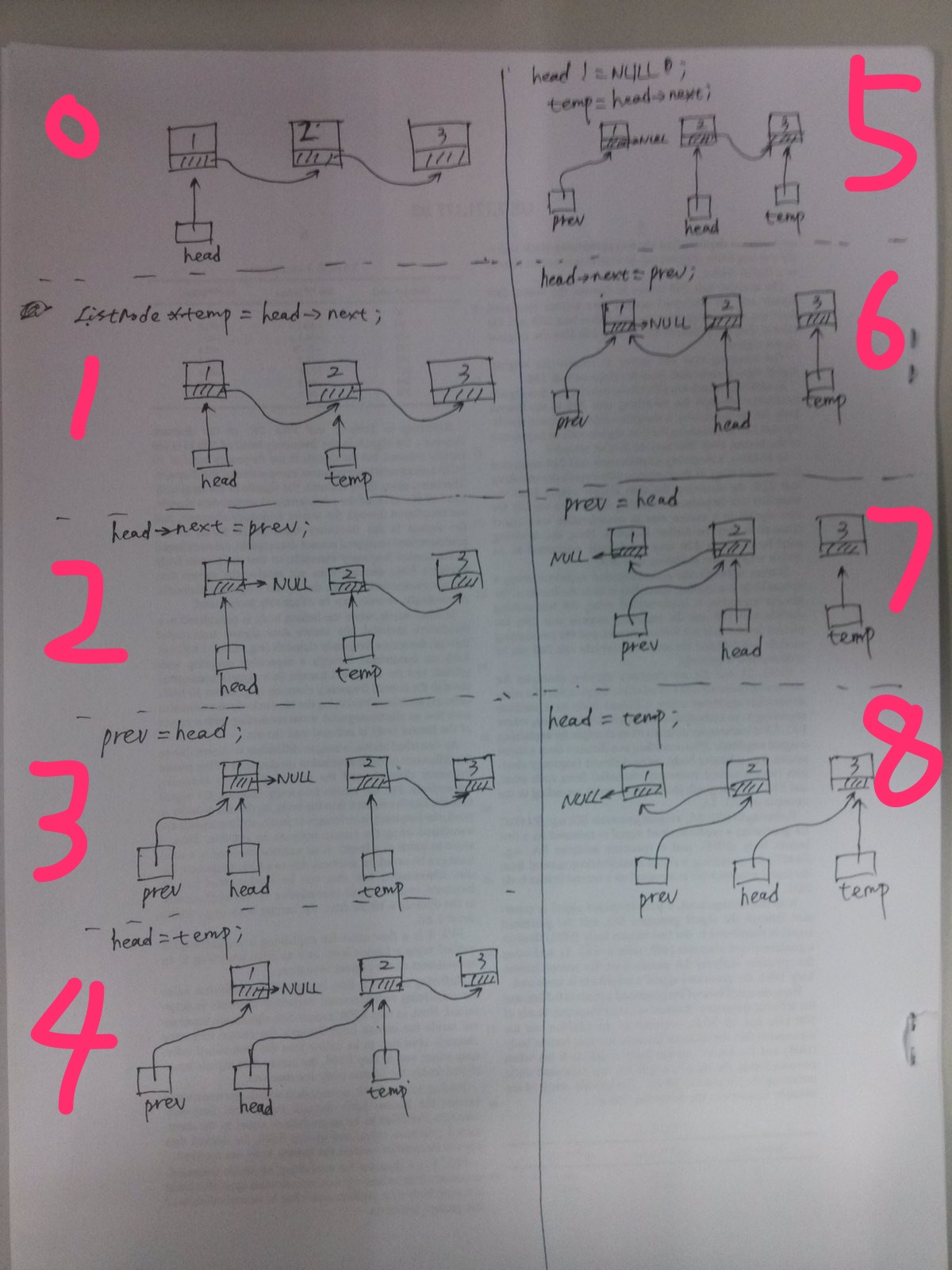Reverse Linked List
Source
- leetcode: Reverse Linked List | LeetCode OJ
- lintcode: (35) Reverse Linked List
Reverse a linked list.
Example
For linked list 1->2->3, the reversed linked list is 3->2->1
Challenge
Reverse it in-place and in one-pass
題解1 - 非遞迴
聯想到同樣也可能需要翻轉的數組,在數組中由於可以利用下標隨機訪問,翻轉時使用下標即可完成。而在單向鏈表中,僅僅只知道頭節點,而且只能單向往前走,故需另尋出路。分析由1->2->3變為3->2->1的過程,由於是單向鏈表,故只能由1開始遍曆,1和2最開始的位置是1->2,最後變為2->1,故從這裡開始尋找突破口,探討如何交換1和2的節點。
temp = head->next;
head->next = prev;
prev = head;
head = temp;
要點在於維護兩個指針變量prev和head, 翻轉相鄰兩個節點之前保存下一節點的值,分析如下圖所示:

- 保存head下一節點
- 將head所指向的下一節點改為prev
- 將prev替換為head,波浪式前進
- 將第一步保存的下一節點替換為head,用於下一次循環
Python
# Definition for singly-linked list.
# class ListNode:
# def __init__(self, x):
# self.val = x
# self.next = None
class Solution:
# @param {ListNode} head
# @return {ListNode}
def reverseList(self, head):
prev = None
curr = head
while curr is not None:
temp = curr.next
curr.next = prev
prev = curr
curr = temp
# fix head
head = prev
return head
C++
/**
* Definition for singly-linked list.
* struct ListNode {
* int val;
* ListNode *next;
* ListNode(int x) : val(x), next(NULL) {}
* };
*/
class Solution {
public:
ListNode* reverse(ListNode* head) {
ListNode *prev = NULL;
ListNode *curr = head;
while (curr != NULL) {
ListNode *temp = curr->next;
curr->next = prev;
prev = curr;
curr = temp;
}
// fix head
head = prev;
return head;
}
};
Java
/**
* Definition for singly-linked list.
* public class ListNode {
* int val;
* ListNode next;
* ListNode(int x) { val = x; }
* }
*/
public class Solution {
public ListNode reverseList(ListNode head) {
ListNode prev = null;
ListNode curr = head;
while (curr != null) {
ListNode temp = curr.next;
curr.next = prev;
prev = curr;
curr = temp;
}
// fix head
head = prev;
return head;
}
}
源碼分析
題解中基本分析完畢,代碼中的prev賦值操作精煉,值得借鑒。
複雜度分析
遍歷一次鏈表,時間複雜度為 , 使用了輔助變數,空間複雜度 .
題解2 - 遞迴
遞迴的終止步分三種情況討論:
- 原鏈表為空,直接返回空鏈表即可。
- 原鏈表僅有一個元素,返回該元素。
- 原鏈表有兩個以上元素,由於是單向鏈表,故翻轉需要自尾部向首部逆推。
由尾部向首部逆推時大致步驟為先翻轉當前節點和下一節點,然後將當前節點指向的下一節點置空(否則會出現死循環和新生成的鏈表尾節點不指向空),如此遞迴到頭節點為止。新鏈表的頭節點在整個遞迴過程中一直沒有變化,逐層向上返回。
Python
"""
Definition of ListNode
class ListNode(object):
def __init__(self, val, next=None):
self.val = val
self.next = next
"""
class Solution:
"""
@param head: The first node of the linked list.
@return: You should return the head of the reversed linked list.
Reverse it in-place.
"""
def reverse(self, head):
# case1: empty list
if head is None:
return head
# case2: only one element list
if head.next is None:
return head
# case3: reverse from the rest after head
newHead = self.reverse(head.next)
# reverse between head and head->next
head.next.next = head
# unlink list from the rest
head.next = None
return newHead
C++
/**
* Definition of ListNode
*
* class ListNode {
* public:
* int val;
* ListNode *next;
*
* ListNode(int val) {
* this->val = val;
* this->next = NULL;
* }
* }
*/
class Solution {
public:
/**
* @param head: The first node of linked list.
* @return: The new head of reversed linked list.
*/
ListNode *reverse(ListNode *head) {
// case1: empty list
if (head == NULL) return head;
// case2: only one element list
if (head->next == NULL) return head;
// case3: reverse from the rest after head
ListNode *newHead = reverse(head->next);
// reverse between head and head->next
head->next->next = head;
// unlink list from the rest
head->next = NULL;
return newHead;
}
};
Java
/**
* Definition for singly-linked list.
* public class ListNode {
* int val;
* ListNode next;
* ListNode(int x) { val = x; }
* }
*/
public class Solution {
public ListNode reverse(ListNode head) {
// case1: empty list
if (head == null) return head;
// case2: only one element list
if (head.next == null) return head;
// case3: reverse from the rest after head
ListNode newHead = reverse(head.next);
// reverse between head and head->next
head.next.next = head;
// unlink list from the rest
head.next = null;
return newHead;
}
}
源碼分析
case1 和 case2 可以合在一起考慮,case3 返回的為新鏈表的頭節點,整個遞迴過程中保持不變。
複雜度分析
遞迴嵌套層數為 , 時間複雜度為 , 空間(不含函數堆疊空間)複雜度為 .